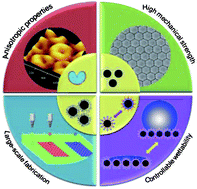Fabrication of functional colloidal photonic crystals based on well-designed latex particles
Abstract
Colloidal photonic crystals (PCs) have attracted a wide research interest due to their special light manipulation properties, demonstrating wide applications in optical sensing materials and various optical devices. In this paper, we review recent research progress related to the fabrication of functional colloidal PCs with tough mechanical properties, controllable wettability and anisotropic structures based on well-designed latex particles. For example, tough colloidal PCs are assembled from latex particles with hard-core and soft-shell structures, or based on a crosslinked structure among latex particles; the wettability of colloidal PCs is controlled by modifying the assembly temperature, pH, electronic potential, etc, using latex particles with well-designed surface chemical composition; the anisotropic colloidal PCs are fabricated based on the particles' anisotropic chemical composition or their response to external fields. Otherwise, large-scale fabrication of colloidal PCs by coating or printing has also been demonstrated based on the use of the latex particles with additional

- This article is part of the themed collection: Materials Chemistry of Nanofabrication

 Please wait while we load your content...
Please wait while we load your content...